Analysis of Active Suspension Control Based on Improved Fuzzy Neural Network PID
Abstract
1. Introduction
2. Materials and Methods
2.1. Active Suspension Simulation Model
- The elastic center of the vehicle body coincides with the center of mass;
- The vehicle body is rigid, and the occupants move in the same way as the vehicle body;
- There is no sliding between the tires and the road, and the wheels are always in contact with the ground;
- The vertical vibration characteristics of the wheel are reduced by a spring that does not take into account the damping effect.
2.2. Road Excitation Model
2.2.1. White Noise Road Excitation
2.2.2. Step Noise Road Excitation
2.3. Controller Design Principle
2.3.1. FNN-PID Controller
2.3.2. PID Control
2.3.3. FNN Control
2.3.4. FNN Optimization Algorithm
- Gradient Descent;
- 2.
- Particle swarm algorithm
2.3.5. Hybrid Algorithm Optimization Process
- The fuzzy neural network parameters, , are initialized;
- Particle swarm initialization. Parameters such as those of population size, particle dimensions, and initial inertia weight, as well as learning factor, are set first, after which a set of particle positions is generated at random and the particle’s maximum and minimum velocities are determined; between the extremes of highest and minimum velocity, each particle’s velocity is determined randomly;
- After updating the velocity and position of the particle, the fitness value of the particle at each iteration step is calculated, and the individual optimal extremum, , and the population optimal extremum, , are updated;
- If the termination condition is satisfied, the corresponding network parameters are passed to the FNN;
- The FNN acquires the initial values of the parameters and then calculates them and updates the network parameters online by back-propagation through the gradient descent method. The final optimal solutions are output.
3. Results
4. Discussion
Author Contributions
Funding
Data Availability Statement
Conflicts of Interest
References
- Manolache-Rusu, I.-C.; Suciu, C.; Mihai, I. Analysis of Passive vs. Semi-Active Quarter Car Suspension Models. In Advanced Topics in Optoelectronics, Microelectronics and Nanotechnologies X; SPIE: Bellingham, WA, USA, 2020; Volume 11718, p. 117181Q. [Google Scholar] [CrossRef]
- Kumar, S.; Medhavi, A.; Kumar, R. Active and Passive Suspension System Performance under Random Road Profile Excitations. Int. J. Acoust. Vib. 2020, 25, 532–541. [Google Scholar] [CrossRef]
- Babawuro, A.Y.; Tahir, N.M.; Muhammed, M.; Sambo, A.U. Optimized State Feedback Control of Quarter Car Active Suspension System Based on LMI Algorithm. J. Phys. Conf. Ser. 2020, 1502, 012019. [Google Scholar] [CrossRef]
- Haemers, M.; Derammelaere, S.; Ionescu, C.-M.; Stockman, K.; De Viaene, J.; Verbelen, F. Proportional-Integral State-Feedback Controller Optimization for a Full-Car Active Suspension Setup Using a Genetic Algorithm. IFAC-PapersOnLine 2018, 51, 1–6. [Google Scholar] [CrossRef]
- Youness, S.F.; Lobusov, E.C. Networked Control for Active Suspension System. Procedia Comput. Sci. 2019, 150, 123–130. [Google Scholar] [CrossRef]
- Nguyen, T.A. Control an Active Suspension System by Using PID and LQR Controller. Int. J. Mech. Prod. Eng. Res. Dev. 2020, 10, 7003–7012. [Google Scholar] [CrossRef]
- Bai, R.; Wang, H.-B. Robust Optimal Control for the Vehicle Suspension System with Uncertainties. IEEE Trans. Cybern. 2021, 52, 9263–9273. [Google Scholar] [CrossRef] [PubMed]
- Jibril, M.; Alluvada, P. Quarter Car Active Suspension System Design Using Optimal and Robust Control Method. Ind. Eng. Lett. 2020, 10, 43. [Google Scholar]
- Li, Z. Evaluating Car’s Ride Comfort and Controlling Vibration of Suspension System Based on Adaptive PID Control. Tech. J. Daukeyev Univ. 2021, 1, 1–9. [Google Scholar] [CrossRef]
- Li, Z.; Chen, L.; Zheng, Q.; Dou, X.; Yang, L. Control of a Path Following Caterpillar Robot Based on a Sliding Mode Variable Structure Algorithm. Biosyst. Eng. 2019, 186, 293–306. [Google Scholar] [CrossRef]
- Saifi, D.; Kumar, P. Modelling of Active Suspension System for Quarter Car (PID Control, MATLAB). Int. J. Eng. Appl. Sci. Technol. 2021, 5, 155–160. [Google Scholar] [CrossRef]
- Khodadadi, H.; Ghadiri, H. Self-Tuning PID Controller Design Using Fuzzy Logic for Half Car Active Suspension System. Int. J. Dyn. Control 2018, 6, 224–232. [Google Scholar] [CrossRef]
- Cao, K.; Li, Z.; Gu, Y.; Zhang, L.; Chen, L. The Control Design of Transverse Interconnected Electronic Control Air Suspension Based on Seeker Optimization Algorithm. Proc. Inst. Mech. Eng. Part D J. Automob. Eng. 2021, 235, 2200–2211. [Google Scholar] [CrossRef]
- Muderrisoğlu, K.; Arisoy, D.O.; Ahan, A.O.; Akdogan, E. PID Parameters Prediction Using Neural Network for A Linear Quarter Car Suspension Control. Int. J. Intell. Syst. Appl. Eng. 2016, 4, 20–24. [Google Scholar] [CrossRef]
- Wang, M.; Pang, H.; Wang, P.; Luo, J. BP Neural Network and PID Combined Control Applied to Vehicle Active Suspension System. In Proceedings of the 2021 40th Chinese Control Conference (CCC), Shanghai, China, 26–28 July 2021; pp. 8187–8192. [Google Scholar]
- Qiu, R. Adaptive Control of Vehicle Active Suspension Based on Neural Network Optimization. E3S Web Conf. 2021, 261, 03046. [Google Scholar] [CrossRef]
- Ahmed, A.A.; Saleh Alshandoli, A.F. Using Of Neural Network Controller and Fuzzy PID Control To Improve Electric Vehicle Stability Based On A14-DOF Model. In Proceedings of the 2020 International Conference on Electrical Engineering (ICEE), Istanbul, Turkey, 28–27 September 2020; pp. 1–6. [Google Scholar]
- Han, S.-Y.; Dong, J.-F.; Zhou, J.; Chen, Y.-H. Adaptive Fuzzy PID Control Strategy for Vehicle Active Suspension Based on Road Evaluation. Electronics 2022, 11, 921. [Google Scholar] [CrossRef]
- Swethamarai, P.; Lakshmi, P. Adaptive-Fuzzy Fractional Order PID Controller-Based Active Suspension for Vibration Control. IETE J. Res. 2022, 68, 3487–3502. [Google Scholar] [CrossRef]
- Sadeghi, M.S.; Varzandian, S.; Barzegar, A. Optimization of Classical PID and Fuzzy PID Controllers of a Nonlinear Quarter Car Suspension System Using PSO Algorithm. In Proceedings of the 2011 1st International Conference on Computer and Knowledge Engineering (ICCKE), Mashhad, Iran, 13–14 October 2011; pp. 172–176. [Google Scholar]
- Gandhi, P.; Adarsh, S.; Ramachandran, K.I. Performance Analysis of Half Car Suspension Model with 4 DOF Using PID, LQR, FUZZY and ANFIS Controllers. Procedia Comput. Sci. 2017, 115, 2–13. [Google Scholar] [CrossRef]
- Shalabi, M.E.; Fath Elbab, A.M.R.; El-Hussieny, H.; Abouelsoud, A.A. Neuro-Fuzzy Volume Control for Quarter Car Air-Spring Suspension System. IEEE Access 2021, 9, 77611–77623. [Google Scholar] [CrossRef]
- Pang, H.; Liu, F.; Xu, Z. Variable Universe Fuzzy Control for Vehicle Semi-Active Suspension System with MR Damper Combining Fuzzy Neural Network and Particle Swarm Optimization. Neurocomputing 2018, 306, 130–140. [Google Scholar] [CrossRef]
- Ghosh, G.; Mandal, P.; Mondal, S.C. Modeling and Optimization of Surface Roughness in Keyway Milling Using ANN, Genetic Algorithm, and Particle Swarm Optimization. Int. J. Adv. Manuf. Technol. 2019, 100, 1223–1242. [Google Scholar] [CrossRef]
- Zhao, Q.; Zhu, B. Multi-Objective Optimization of Active Suspension Predictive Control Based on Improved PSO Algorithm. J. Vibroeng. 2019, 21, 1388–1404. [Google Scholar] [CrossRef]
- Yuan-chun, K. Fatigue Analysis of Suspension Control Arm Based on Road Spectrum. IOP Conf. Ser. Mater. Sci. Eng. 2019, 538, 012062. [Google Scholar] [CrossRef]
- Zhou, Z.C.; Chen, R. Design on Fuzzy Neural Network PID Control System of Diesel Engine. Adv. Mater. Res. 2013, 756–759, 425–429. [Google Scholar] [CrossRef]
- Borase, R.P.; Maghade, D.K.; Sondkar, S.Y.; Pawar, S.N. A Review of PID Control, Tuning Methods and Applications. Int. J. Dyn. Control 2021, 9, 818–827. [Google Scholar] [CrossRef]
- Cao, P.; Zhao, W.; Liu, S.; Shi, L.; Gao, H. Using a Digital Camera Combined with Fitting Algorithm and T-S Fuzzy Neural Network to Determine the Turbidity in Water. IEEE Access 2019, 7, 83589–83599. [Google Scholar] [CrossRef]
- Jain, N.K.; Nangia, U.; Jain, J. A Review of Particle Swarm Optimization. J. Inst. Eng. India Ser. B 2018, 99, 407–411. [Google Scholar] [CrossRef]
- Bansal, J.C. Particle Swarm Optimization. In Evolutionary and Swarm Intelligence Algorithms; Bansal, J.C., Singh, P.K., Pal, N.R., Eds.; Studies in Computational Intelligence; Springer International Publishing: Cham, Switzerland, 2019; pp. 11–23. ISBN 978-3-319-91341-4. [Google Scholar]
- Dogo, E.M.; Afolabi, O.J.; Nwulu, N.I.; Twala, B.; Aigbavboa, C.O. A Comparative Analysis of Gradient Descent-Based Optimization Algorithms on Convolutional Neural Networks. In Proceedings of the 2018 International Conference on Computational Techniques, Electronics and Mechanical Systems (CTEMS), Belgaum, India, 21–22 December 2018; pp. 92–99. [Google Scholar]
- Lv, S.; Chen, G.; Dai, J. Active Suspension Control Based on Particle Swarm Optimization. Recent Pat. Mech. Eng. 2020, 13, 60–78. [Google Scholar] [CrossRef]
- Bejarbaneh, E.Y.; Bagheri, A.; Bejarbaneh, B.Y.; Buyamin, S.; Chegini, S.N. A New Adjusting Technique for PID Type Fuzzy Logic Controller Using PSOSCALF Optimization Algorithm. Appl. Soft Comput. 2019, 85, 105822. [Google Scholar] [CrossRef]

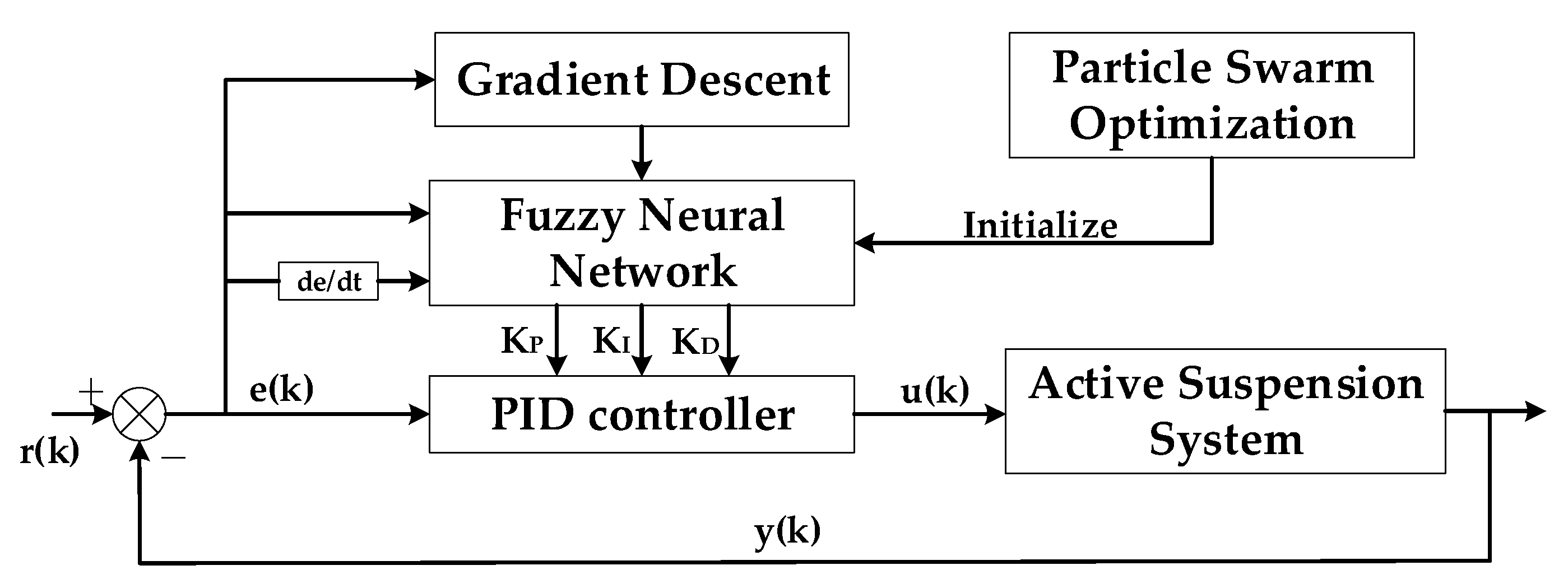
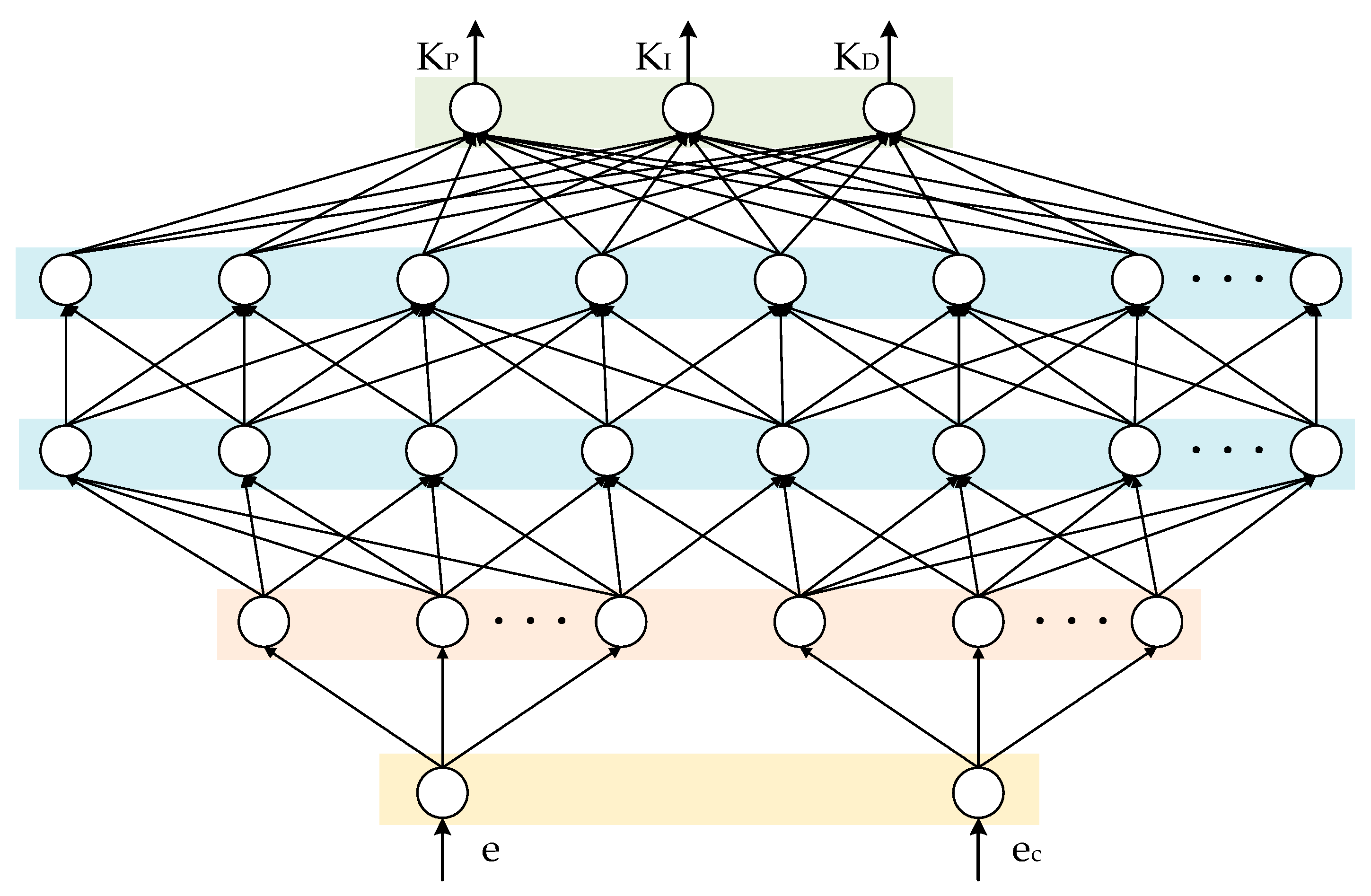

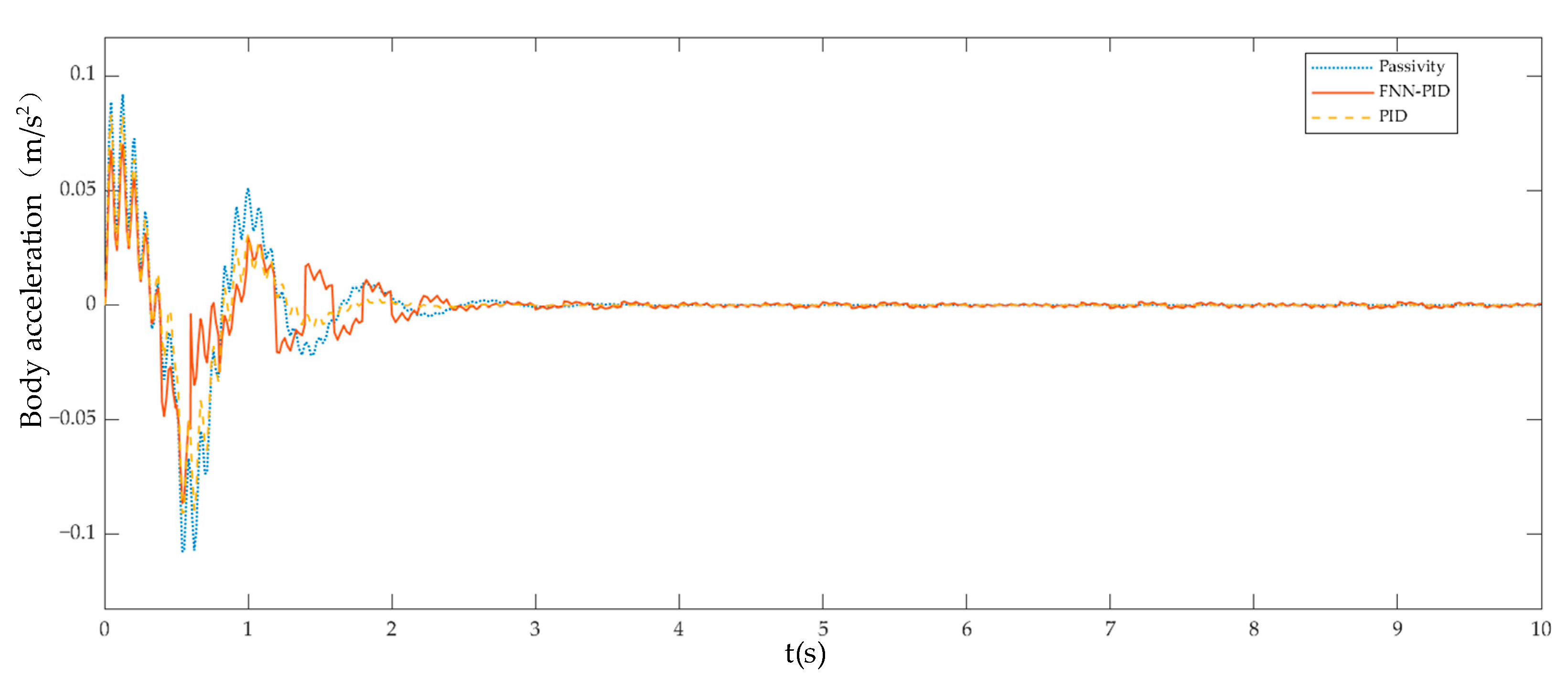
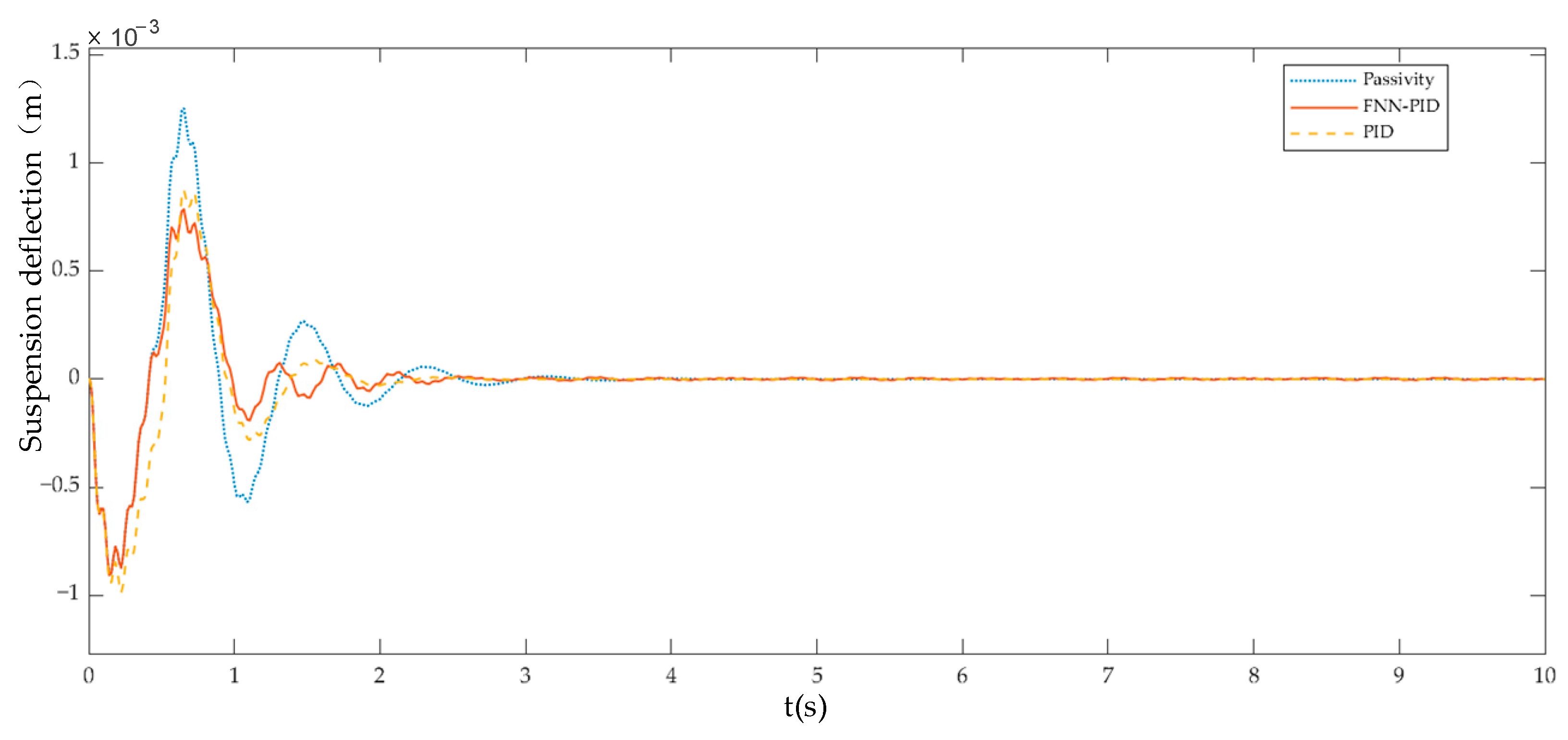
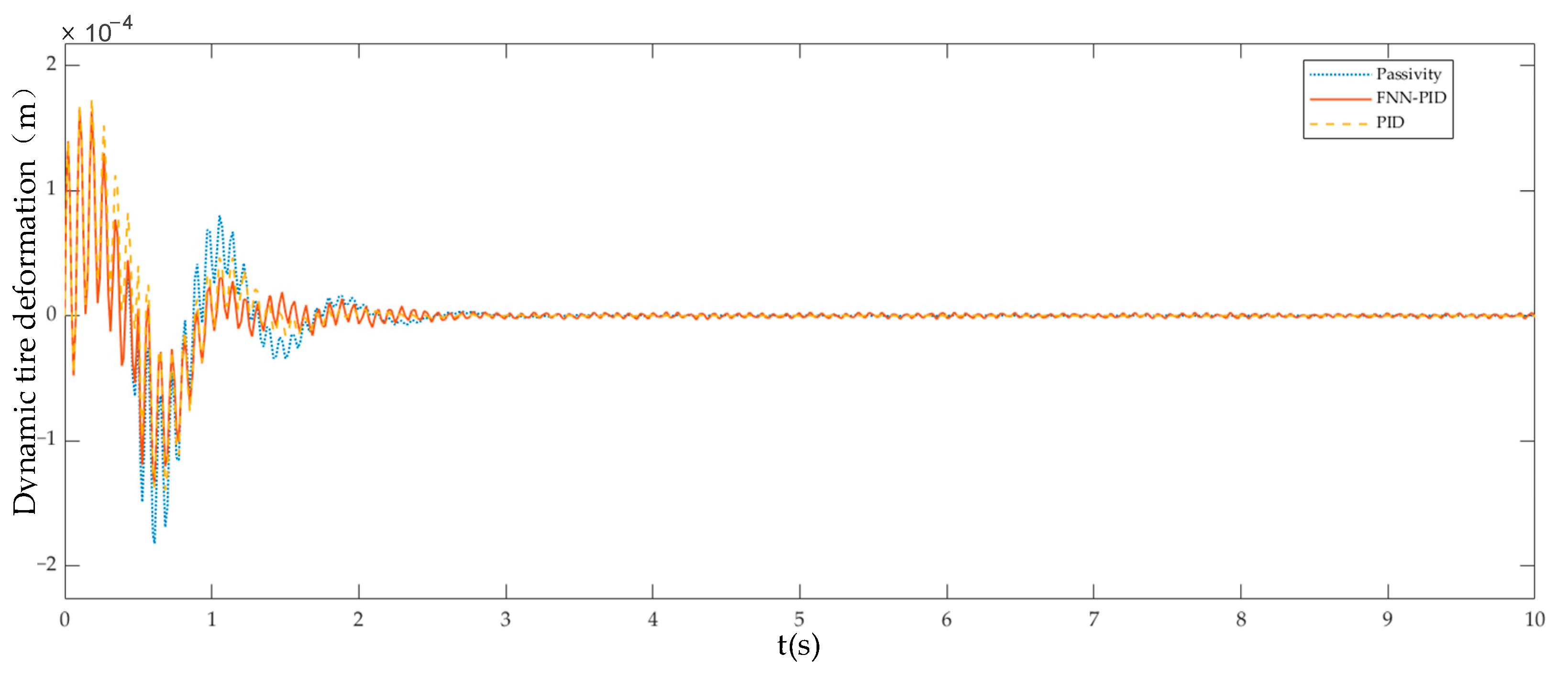


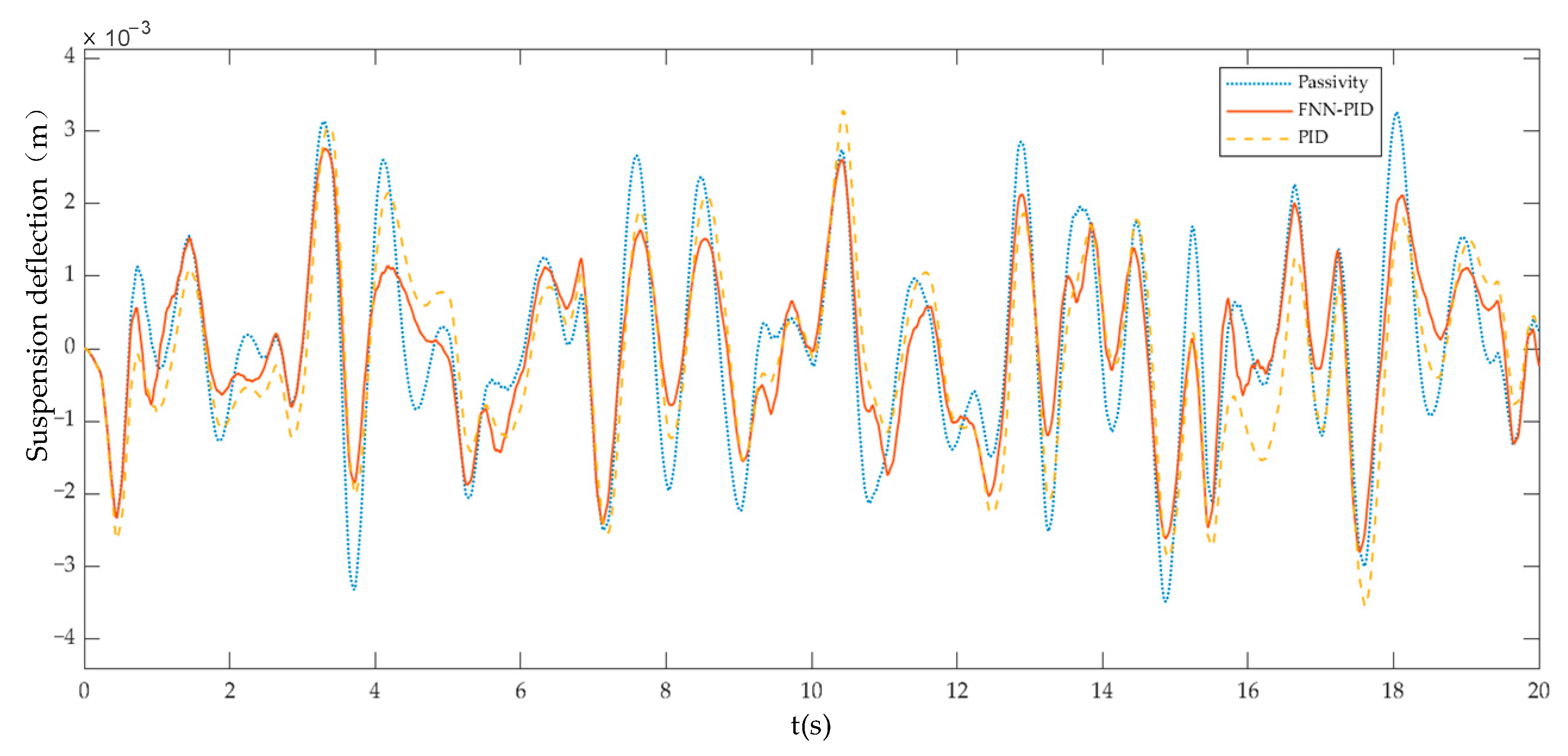

| Road Grade | |
|---|---|
| A | 16 |
| B | 64 |
| C | 256 |
| D | 1024 |
| Variable | Value |
|---|---|
| Sprung mass M/kg | 240 |
| Unsprung mass m/kg | 30 |
| Tire stiffness K1/(N/m) | 160,000 |
| Spring rate K2/(N/m) | 16,000 |
| Suspension damping c/(N•s)/m | 980 |
| Index | Passive | PID Controller | FNN-PID Controller |
|---|---|---|---|
| SMA (m/s2) | |||
| DDS (m) | |||
| DTD (m) |
| Class | Index | Passive | PID Controller | FNN-PID Controller |
|---|---|---|---|---|
| A | SMA (m/s2) | 0.0490 | 0.0391 | 0.0334 |
| DDS (m) | ||||
| DTD (m) | ||||
| B | SMA (m/s2) | 0.0979 | 0.0782 | 0.0681 |
| DDS (m) | ||||
| DTD (m) | ||||
| C | SMA (m/s2) | 0.1820 | 0.1440 | 0.1257 |
| DDS (m) | ||||
| DTD (m) | ||||
| D | SMA (m/s2) | 0.3476 | 0.2673 | 0.2390 |
| DDS (m) | ||||
| DTD (m) |
Publisher’s Note: MDPI stays neutral with regard to jurisdictional claims in published maps and institutional affiliations. |
© 2022 by the authors. Licensee MDPI, Basel, Switzerland. This article is an open access article distributed under the terms and conditions of the Creative Commons Attribution (CC BY) license (https://creativecommons.org/licenses/by/4.0/).
Share and Cite
Li, M.; Li, J.; Li, G.; Xu, J. Analysis of Active Suspension Control Based on Improved Fuzzy Neural Network PID. World Electr. Veh. J. 2022, 13, 226. https://doi.org/10.3390/wevj13120226
Li M, Li J, Li G, Xu J. Analysis of Active Suspension Control Based on Improved Fuzzy Neural Network PID. World Electric Vehicle Journal. 2022; 13(12):226. https://doi.org/10.3390/wevj13120226
Chicago/Turabian StyleLi, Mei, Jiapeng Li, Guisheng Li, and Jie Xu. 2022. "Analysis of Active Suspension Control Based on Improved Fuzzy Neural Network PID" World Electric Vehicle Journal 13, no. 12: 226. https://doi.org/10.3390/wevj13120226
APA StyleLi, M., Li, J., Li, G., & Xu, J. (2022). Analysis of Active Suspension Control Based on Improved Fuzzy Neural Network PID. World Electric Vehicle Journal, 13(12), 226. https://doi.org/10.3390/wevj13120226






